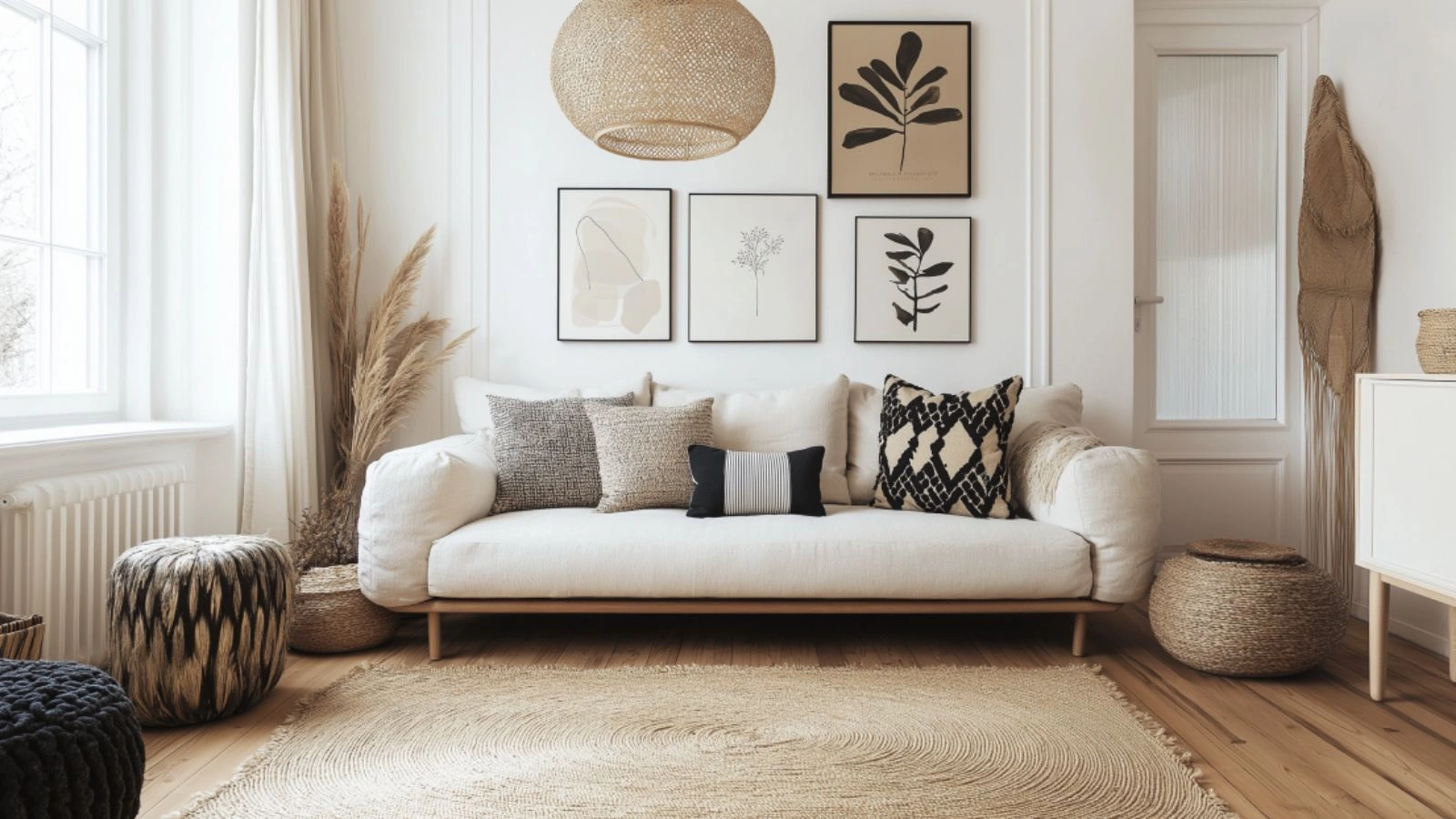How to Mix Patterns and Textures in a Cozy Eclectic Living Room for Effortless Style
Table of Contents
Have you ever stepped into a room that felt effortlessly layered—bohemian, cozy, and vibrant—all at once? That’s the beauty of a well-designed eclectic living room. It’s a space where global rugs, velvet sofas, tribal prints, and woven baskets can all coexist beautifully. But while eclectic style invites freedom, it also demands balance. Mixing patterns and textures successfully can mean the difference between curated charm and visual clutter.
This post is for anyone who loves bold design but wants to avoid overwhelm. If you’ve ever wondered how to combine leopard print with florals, or velvet with jute, you’re in the right place. We’ll explore how to blend contrasting textures, pair diverse prints, and maintain visual flow while keeping your space warm and inviting.
From foundational rules to advanced styling ideas, you’ll get practical, room-ready advice to turn your living room into a design storybook. Whether your style leans more boho, mid-century, or global chic, you’ll walk away with tips and visuals to help you master the eclectic look without the chaos.
Start With a Balanced Foundation
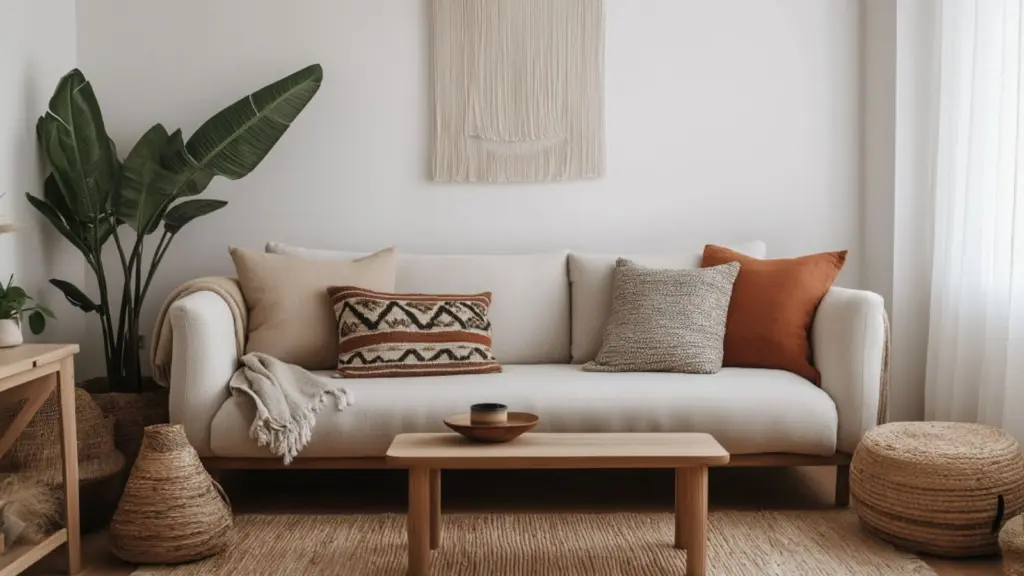
Before layering patterns and textures, begin with a solid base that supports your eclectic story. Think of this as the neutral backdrop—a calming canvas that allows your patterns to shine without competing.
Your foundation includes wall color, flooring, large furniture, and foundational textiles like rugs and curtains. Choosing mostly neutral or muted tones for these elements (think ivory, clay, taupe, or sage) will create space for louder patterns and richer textures to layer on top.
For example, a soft linen couch in oatmeal sets a quiet stage for bold tribal pillows, while white walls make graphic wallpaper on one accent wall pop without overpowering the room.
Foundation Balance Table
| Element | Suggested Approach |
|---|---|
| Wall Color | Soft whites, earth tones, or warm grays |
| Large Furniture | Neutral or solid-colored upholstery |
| Flooring | Wood, jute rugs, or simple tiles |
| Curtains | Linen, cotton, or light-pattern sheers |
Mix Patterns with Purpose, Not Panic
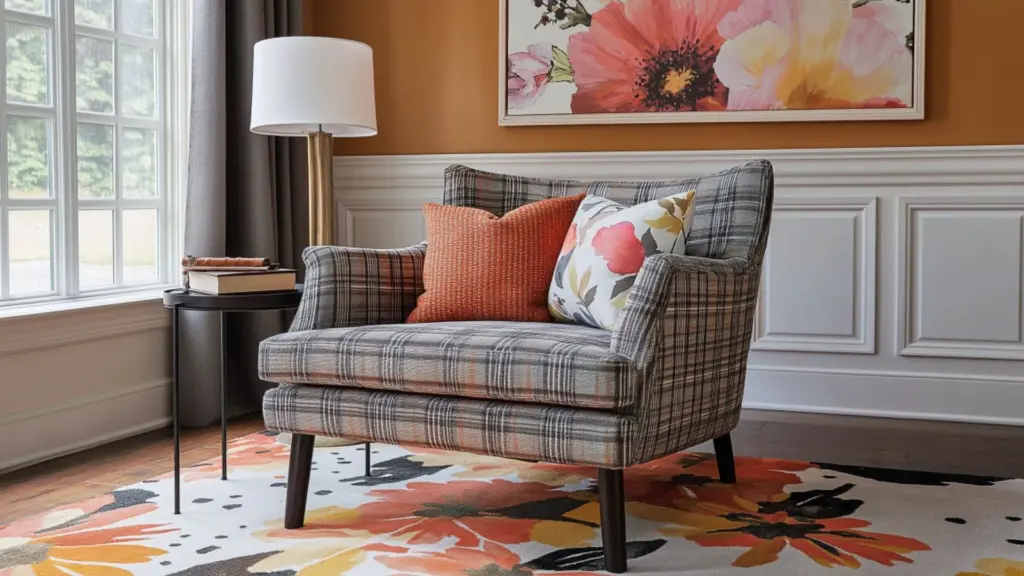
The secret to mixing patterns lies in repetition and scale. A good rule of thumb? Combine patterns in at least three sizes: small, medium, and large. This creates visual rhythm and ensures no single pattern dominates the scene.
Start with one pattern you absolutely love. Let it inspire your color palette and influence the others you choose. Say you’re drawn to a large-scale vintage floral rug—balance it with medium-sized plaid on an armchair and small-scale polka dots on a throw pillow.
Keep colors consistent. Even wildly different patterns will work together if they share a common color or tone. Mixing geometrics with botanicals or stripes with animal prints becomes easier when they live in the same palette.
Pattern Mixing Cheat Sheet
| Pattern Size | Examples | Where to Use |
|---|---|---|
| Large | Bold florals, oversized geometrics | Rugs, statement chairs, wall murals |
| Medium | Plaid, tribal motifs, abstract shapes | Throw blankets, curtains, ottomans |
| Small | Dots, pinstripes, micro florals | Pillows, lampshades, accent accessories |
Use Texture to Ground Bold Patterns
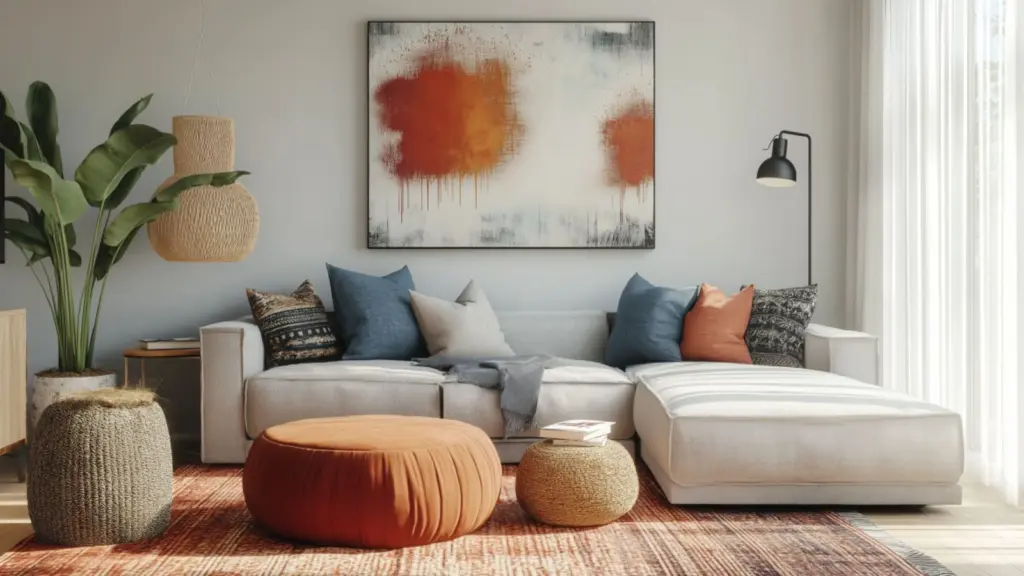
While patterns add visual interest, textures bring depth and warmth. Layering different materials—like velvet, leather, wool, rattan, and ceramics—adds tactile richness to your space. This is especially important in an eclectic room, where a mix of items needs cohesion.
Pair smooth textures (like glass or metal) with rougher ones (such as a chunky knit or rattan basket) to keep the eye engaged. A velvet sofa looks even more inviting with a sheepskin draped across it, while a raw wood coffee table contrasts beautifully with a polished ceramic vase.
Textures can also calm down loud patterns. If you have a busy gallery wall or multiple bold textiles, balance them with soft neutral textures like linen curtains or a jute rug to ground the space.
Texture Layering Table
| Material Type | Examples | Effect |
|---|---|---|
| Soft Textures | Velvet, wool, faux fur | Cozy and inviting |
| Natural Textures | Wood, leather, rattan | Earthy and grounding |
| Hard Textures | Metal, ceramic, glass | Polished and modern |
Color as the Unifier in Eclectic Rooms
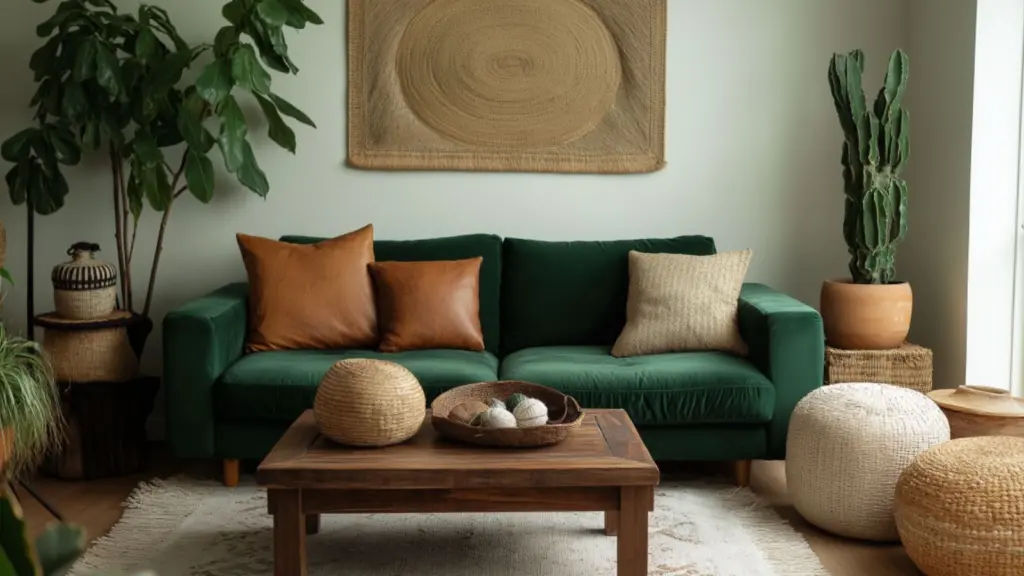
When patterns and textures are competing for attention, color becomes the unifying force. A consistent color palette pulls the room together, even if your patterns range from leopard to paisley.
Pick 2–3 base colors, then weave them throughout your decor using solids, prints, and materials. For example, a palette of terracotta, deep green, and ivory can show up in velvet pillows, an abstract print, and a ceramic lamp. This repetition helps the eye flow through the space effortlessly.
Don’t be afraid of contrast, but stay within a cohesive scheme. Jewel tones pair beautifully with earthy neutrals, while soft pastels work well in light-filled boho spaces.
Color Palette Builder
| Base Color | Accent Color 1 | Accent Color 2 | Neutral Support |
|---|---|---|---|
| Terracotta | Olive Green | Mustard Yellow | Cream or Sand |
| Dusty Blue | Rust Red | Warm Beige | Gray or White |
| Sage Green | Blush Pink | Charcoal Gray | Linen or Taupe |
Anchor the Space with Statement Pieces
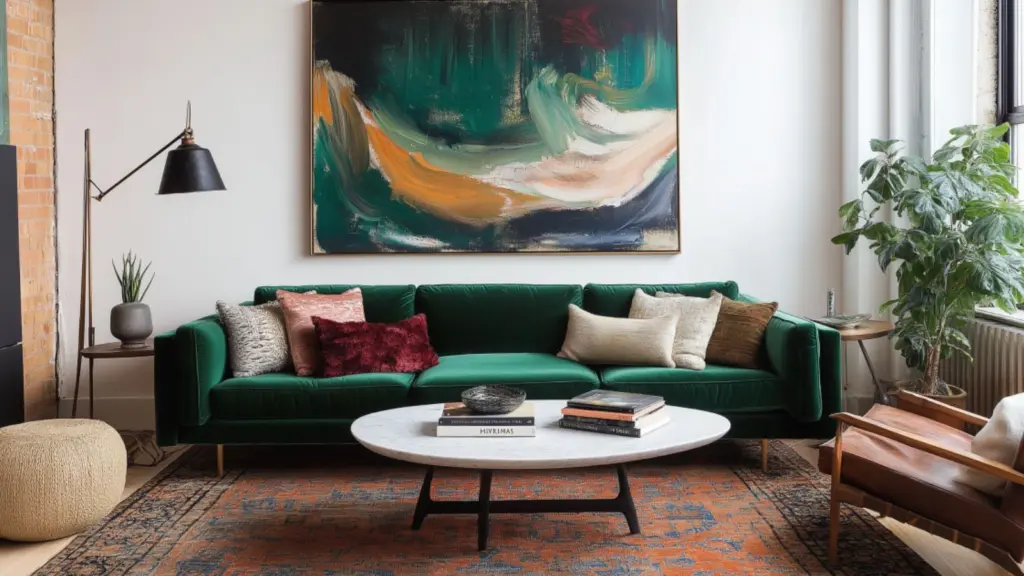
In a room full of layers, statement pieces provide visual direction. These are your conversation starters—maybe a bold mid-century chair, a Moroccan rug, or a hand-carved coffee table.
Choose one or two large elements to anchor the room, then style around them. A colorful vintage couch, for instance, can set the tone for everything from artwork to accent pillows. Similarly, a wall-sized textile or unique bookshelf helps define the eclectic look while keeping it from feeling chaotic.
Your statement doesn’t always have to be large. A bold patterned lampshade or oversized art print can also serve as a visual anchor.
Statement Styling Breakdown
| Statement Piece | Styling Notes |
|---|---|
| Vintage Rug | Ground the furniture layout |
| Bold Sofa | Echo its color in small accessories |
| Oversized Wall Art | Keep adjacent décor simple |
| Unique Coffee Table | Style with neutral or natural items |
Styling with Layers—Pillows, Throws, and Wall Decor
When it comes to layering, accessories like pillows, throws, and wall art are your best friends. They offer low-commitment ways to experiment with patterns and textures, and they can change seasonally or with your mood.
Start with a solid base on your couch or chair—perhaps a linen or velvet in a neutral shade. Now add layers: pillows with fringe, block prints, or embroidery. A patterned throw can bring in new colors or echo existing ones.
Don’t ignore vertical space. Use wall baskets, macrame, vintage frames, or even tapestries to add texture to your walls. These elements add visual height and balance to the room’s composition.
Create visual movement by overlapping items. Let a throw spill over the couch edge. Stack pillows in mismatched but coordinated pairs. Lean framed art casually on a console table. These subtle styling choices create a lived-in, collected vibe.
Layering Accessories Table
| Accessory Type | Pattern Ideas | Texture Ideas |
|---|---|---|
| Pillows | Block print, stripes | Velvet, woven, tassels |
| Throws | Tribal, chevron | Chunky knit, faux fur |
| Wall Decor | Tapestry, gallery wall | Rattan, wood carvings |
Creating Visual Flow in a Collected Space
One challenge of the eclectic look is avoiding visual fragmentation. You want a collected feel—not a chaotic one. Achieving flow means your eye should naturally travel across the room without stopping abruptly or getting stuck.
Create zones within your living room. A reading nook, conversation corner, or media area should each have a purpose and be subtly defined—perhaps by an area rug, floor lamp, or furniture layout.
Visual repetition is also key. If you use a basket texture on one side of the room, mirror it on the other. Echo shapes as well: round pillows, a round ottoman, and a circular wall mirror can tie together disparate items.
Be intentional about negative space. Every corner doesn’t need to be filled. Breathing room helps highlight the details you’ve worked so hard to curate.
Visual Flow Framework
| Principle | How to Apply |
|---|---|
| Repetition | Repeat colors, shapes, or materials |
| Zoning | Use rugs or lighting to define areas |
| Negative Space | Leave space around statement items |
| Anchoring Symmetry | Balance tall and low elements evenly |
Conclusion
An eclectic living room filled with mixed patterns and textures is more than just stylish—it’s a reflection of your personality. Every layered rug, stitched pillow, or framed print adds to the story of who you are.
The key is intention. With a thoughtful approach to color, scale, and texture, your space can feel both visually rich and deeply comforting. You don’t need to follow strict design rules—but understanding the basics gives you the freedom to break them beautifully.
Whether you’re starting from scratch or refreshing a corner, embrace the art of layering and curating. Let your living room be a place of comfort, creativity, and authenticity.

